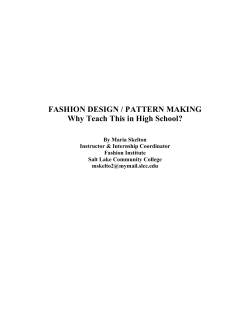
What is a Designer Baby?
Works Cited What is a Designer Baby? The term “designer baby,” refers to the genetic interventions into pre-implantation embryos in the attempt to influence the traits that the resulting offspring will have. Essentially it is a term used by journalists, not scientists. A more realistic term would be “Selected Baby”. It is currently not attainable to insert genes into embryos in hopes of desired characteristic traits or physical features, however advanced technologies can be used to select the sex of your future offspring as well as the ability to screen for certain genetic defects (it is only legal in certain countries). If Designer Babies were Attainable Cons Some would argue that it would demean the uniqueness of each individual, therefore undermining humanity. It would provide those with an unfair competitive advantage over the unenhanced, and it could widen the existing social gap between those who can and cannot afford the new treatment. Pros Genetic engineering of babies would enable parents to avoid the hardships and economic burdens that accompany the birth of a child with an incurable disease, new & better genes passed on to others, ability to enhance muscles, height, intelligence, to choose the sex, hair colour and even personality of our children (2002). In BIONET. Retrieved May 15, 2012, from http://www.bionetonline.org/English /Content/db_cont1.htm Brownlee, S. (2002, March). Designer Babies. Washington Monthly, 34(3). Retrieved May 5, 2012, from the EBSCO database Chan, A. W. S. et al. Transgenic monkeys produced by retroviral gene transfer into mature oocytes. Science 291, 309-312 (January 12, 2000). Genetic Engineering - Designer Babies. (2010). In Future Human Evolution. Retrieved May 7, 2012, from http://www.humansfuture.org/genet ic_engineering_designer_babies. php.htm Lemonick, M. D. (1999, January 11). Designer Babies. Time Magazine. Retrieved May 15, 2012, from http://www.ecasd.k12.wi.us/faculty/ dsampson/designer%203.pdf Ren, Y. (2005). Designer Babies: The Pros and Cons of Genetic Engineering. Massachusetts Institute of Technology Undergraduate Research Journal, 12, 28-32. Retrieved May 15, 2012, from http://web.mit.edu/murj/www/v12/v12Features/v12-f4.pdf Steinbock, B. (2008, October 11). Designer babies: choosing our children's genes. The Lancet, 372(9646), 1294 -1295. doi:10.1016/S0140 -6736(08)61345-8 Genetic Engineering: Designer Babies Pictures: http://www.futuremorph.org/my_future_finder/viewit em.cfm?cit_id=5044 http://www.theglobeandmail.com/life/parenting/preg nancy/pregnancy-trends/the-price-of-embryoscreening/article2294658/ http://www.scq.ubc.ca/preimplantation-geneticdiagnosis-and-our-future-should-we-be-peering-intothe-womb/ By: JV Statistics - In 1985, there were 30 fertility clinics in the U.S. - Ten years later, there were more than 300 - More than one million couples seek fertility treatment each year and spend more than 3 bill in pursuit of babies - Fees for IVF vary between $5000 - $15000 with another $2-3 thousand for fertility drugs - PGD adds several thousand dollars - Clinic success rates improved from 17% in 1992 for women under 40 to nearly 30% in 1999 - Success rates vary wildly from 14% to as high as 60% - Since 1980, according to the National Center for health statistics the number of twins born per year has risen 67% - The rate of triplets and higher-order birth multiples has soared from 37 per 100 000 live births in 1980 to 184 per 100 000 in 1999 - In 2001, the American Society for Reproductive Medicine recommended transferring at most 2 embryos to the mother’s womb for younger patients while older women can recieve as many as 5 - PGD is legal in the U.S. and Australia, but illegal in the United Kingdom (unless used for genetic disorders), Denmark, Italy, Portugal, Spain, New Zealand, and Germany Pre-Implantation Genetic Diagnosis (PGD) PGD is an in vitro fertilization technique in which embryos (an unborn offspring in the process of development) are created outside the womb and can then be tested for genetic disorders and gender. Unfertilized eggs will be removed from the patient, fertilized in a petri dish and then brought to a zygote (eight-cell) stage at which point cells are removed and then tested using PGD. It is useful as it can help to reduce the chances that a child will be born with a genetic disorder. Interesting Find Screening for Genetic Defects with PGD Only specific disorders can be tested for, there is no generic test available as a “catch-all”. It is necessary for a disorder to be pre-identified i.e., it’s known that parents are likely to pass on the disorder or disease to their offspring. Polymerase chain reaction is used on single cells to identify disorders such as: B-Thalassaemia Li Fraumeni syndrome, cystic fibrosis, Duchenne muscular dystrophy (X-linked recessive trait that weakens the muscles), and etc. In brief, a polar body or a blastomere is placed in a solution that lyses the cell and releases the DNA. A PCR reaction mix is then added and PCR begins Using PGD for Sex Selection The researchers at the Genetics & IVF Institute in Fairfax took advantage of a simple rule in biology: girls have two X chromosomes whereas boys have one X and one Y chromosome. In order to choose the sex of the offspring, the power lies within the father’s sperm. Y chromosomes have less DNA than X’s. So, by staining the sperm’s DNA with a nontoxic light-sensitive dye, the Virginia scientists were able to sort sperm by gender with a high rate of success In 2003, Aushalom Caspi and colleagues reported in Science that a functional polymorphism in the promoter region of the serotonin transporter (5-HTT) gene may be associated with a predisposition towards depression. Individuals with 1 or 2 copies of the short allele of the 5-HTT promoter polymorphism become depressed more often after stressful events than individuals homozygous for the long allele. Future Outlook Scientists will need to do a lot more work on identifying and isolating the specific genes that control the growth and development of each individual feature, trait, characteristic or talent. They will need to work out how to alter the DNA so that the child will match with the parent’s request. The formation of the human is a highly complex process of interaction & interweaving. It is possible to imagine a society where children can be bred for specific purposes like off planet living where genetic manipulation is essential for survival.
© Copyright 2025





















